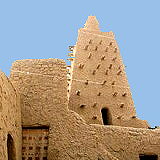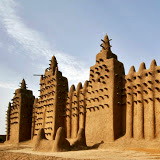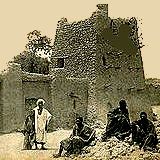
|
Djinguereber Mosque Askia Mohamed Bvd, Timbuktu, Mali ☎ +223 66 63 15 28 Last Updated: 09/13/2023 |
| The Djinguereber Mosque, located in Timbuktu, Mali, is one of the most famous and historic mosques in West Africa. The mosque is a testament to the rich history of Timbuktu and its importance as a center of Islamic scholarship and culture in Africa. | |
| Architecture: The mosque is a remarkable example of Sahelian architecture, characterized by its use of adobe mud bricks and distinctively Saharan design elements. It features a large, flat roof, a central courtyard, and a towering minaret. The use of mud bricks helps regulate the temperature inside the mosque. History: The Djinguereber Mosque was constructed in the 14th century, specifically in 1327, by the order of Emperor Musa I of Mali during the Mali Empire's zenith. The mosque was designed by an architect from Andalusia, Spain, and it is one of the oldest and most well-preserved mud-brick mosques in the world. Cultural Significance: The mosque has deep cultural and historical significance, serving not only as a place of worship but also as a symbol of Timbuktu's role as a center of learning and trade during the medieval period. It was a focal point for Islamic scholarship and intellectual exchange. Design and Layout: The mosque's design incorporates elements that are well-suited to the Saharan environment. The flat roof and mud brick construction help to keep the interior cool in the scorching desert heat. The central courtyard, flanked by columns and arches, provides a spacious area for worship. UNESCO World Heritage Site: The Djinguereber Mosque is part of the larger ensemble of historic mosques and buildings in Timbuktu that collectively form a UNESCO World Heritage Site. This recognition highlights the importance of Timbuktu as a center of culture, trade, and scholarship in Africa's history. Restoration and Preservation: Like other historic sites in Timbuktu, the Djinguereber Mosque has faced threats from political instability and conflicts. Efforts have been made to restore and preserve the mosque and its cultural heritage. Contemporary Significance: The mosque continues to be an active place of worship and a symbol of Timbuktu's enduring cultural legacy. It also attracts visitors and scholars interested in exploring the history and architecture of the region. | |
Wikipedia
Mali » Mli
Place » Temple

|
Mali Place » City Mali is a landlocked country and is the largest country in West Africa and is known for its diverse landscape, which includes the Sahara Desert in the north, the Sahel region in the central part, and the Sudanese savannah in the south. The Niger River flows through the southern part of the country, providing vital water resources and fertile land. The population of Mali was 21,359,722 in 2023. 167 views 💖 1 👍 0Mali |

|
Great Mosque of Djenne Place » Temple Great Mosque of Djenne is a large banco or adobe building. The mosque is considered by many architects to be one of the greatest achievements of the Sudano-Sahelian architectural style. 327 views 💖 1 👍 0Djenné, Mali |

|
Sidi Yahya Mosque Place » Temple The Sidi Yahya Mosque, located in the heart of Timbuktu, Mali, is a historic and culturally significant religious monument. The Sidi Yahya Mosque, with its unique architectural style and historical significance, continues to draw visitors, researchers, and those interested in exploring the cultural heritage of Timbuktu and its role in Islamic scholarship in West Africa. 457 views 💖 1 👍 0Timbuktu, Mali |
